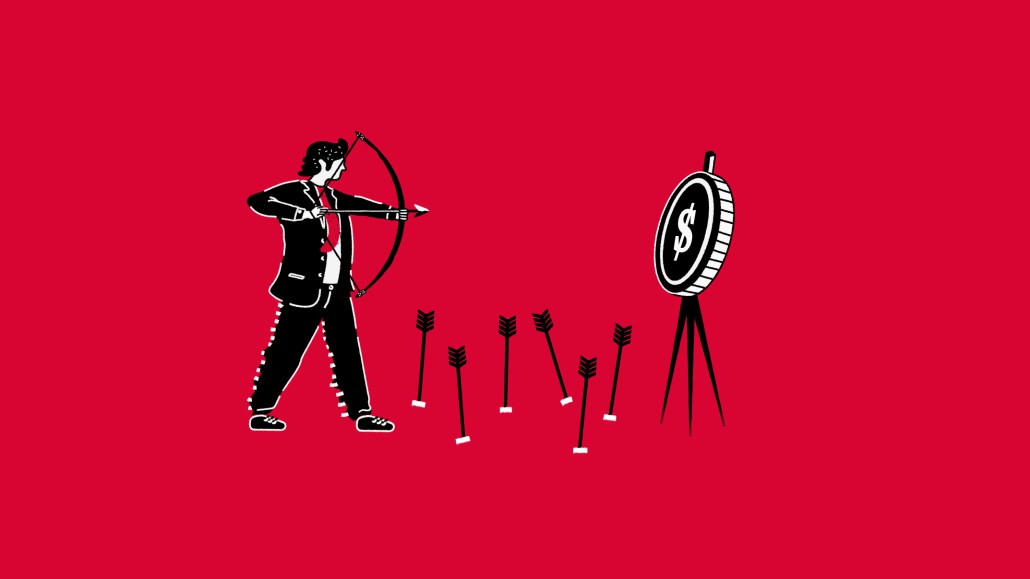Save 50% on a 3-month Digiday+ membership. Ends Dec 5.
‘Throwing spaghetti against the wall’: Why marketers are expanding experimental budget testing

Over the last year of pandemic-induced disruptions and accelerations, more marketers have increased the percentage of their digital ad dollars to experiment with emerging platforms and technologies like TikTok and SMS.
The coronavirus crisis has upended the way people shop as the industry knows it. Consumers are spending significantly more time online to shop, stream and connect with others, forcing marketers to be flexible and diversify their media spend in a move to meet customers where they are.
There’s also the looming depreciation of third-party cookies, stifling programmatic efforts, and social media’s pay to play environment isn’t conducive to the tightened media budgets that lay in the pandemic’s wake, according to marketers.
“What used to be a more linear customer journey is now all over the place,” said Jill John, chief customer officer at direct-to-consumer furniture company Interior Define. “So we want to make sure we’re messaging in a relevant way across multiple stages in the funnel across multiple target audiences.”
In addition to doubling their total digital marketing budget this year, Interior Define has grown its experimental budget from 5% to 15%, according to a company spokesperson. The majority of the DTC brand’s ad dollars go toward performance marketing tactics. But in a recent effort to diversify media spend and reach more consumers, John said the team has launched SMS marketing efforts, podcasts, direct mail, CTV and influencer-focused marketing.
“A lot of this testing budget and reason for diversifying is just reading where our customers are going,” John said. “We have found through COVID that there’s all these different platforms where our customers are now joining.”
Several other brands have also upped their experimental budgets and moved to diversify their media spend over the last year. Media buyers say flexible media channels like CTV are gaining traction, while cable television ads are less attractive in today’s volatile business and fragmented viewer environment.
Ad position: web_incontent_pos1
For example, footwear brand Reef dedicated 5% of its digital media budget toward experimental channels such as text-based marketing and CTV last year. Meanwhile, DTC men’s soap brand Dr. Squatch dedicated 10% of its digital ad budget to Snapchat after finding success in experimenting with the platform.
It’s a similar story on the agency side, per Chelsea Cannon, associate media director at full-service digital marketing agency Chemistry.
Cannon said Chemistry has all but made it mandatory for 5% to 15% of client campaign budget to go toward experimental channels in light of the pandemic “because you just never knew.” It’s a budget that was non-existent before the onset of the coronavirus crisis, she said.
“We almost started redoing budgets on a monthly and weekly basis because everything was going to hell in a hand basket,” she said.
Prior to the pandemic, the majority of Chemistry’s marketing tactics were in line with paid social media and search, Cannon said. But with the pandemic tightening budgets, social media’s pay to play environment made the agency look toward alternative channels such as direct mail and sms marketing.
Ad position: web_incontent_pos2
“We got used to pivoting quickly and thinking outside of the box,” Cannon said. “Nothing else could surprise us at this point.”
“The biggest trend is that there is no trend right now,” said Gordon Zellner, CEO of Evergreen Trading agency. “The notion of set it and forget it, it sounds good, but the business climate is not conducive to [that] right now.
As a media trading firm that buys clients out of media assets that aren’t showing a return on investment, Evergreen has seen a good year, per Zellner. During the pandemic, the firm had a number of cases in which clients needed to cancel media quickly, but couldn’t because of contracts and financial commitments. Evergreen fulfills those commitments on behalf of with the promise that the client buying media from Evergreen in the future, offering the industry flexibility in media buying.
Even as vaccine rollout continues and consumers return to the outside world and normalizing behavior, Zellner thinks experimental budgets are here to stay. In fact, he says they should be integrated into core marketing strategies because “you’re throwing spaghetti against the wall to see what sticks, but it’s a moving wall.”
“I think it has to be a constant testing process where you’re kind of dialing in and adjusting,” he added. “Breaking things into smaller pieces and constantly adjusting and revising I think is the way to go.”
More in Marketing

Ulta, Best Buy and Adidas dominate AI holiday shopping mentions
The brands that are seeing the biggest boost from this shift in consumer behavior are some of the biggest retailers.

U.K. retailer Boots leads brand efforts to invest in ad creative’s data layer
For media dollars to make an impact, brands need ad creative that actually hits. More CMOs are investing in pre- and post-flight measurement.

‘AI is permeating everything we do’: How Guitar Center developed 2 AI tools this year
This summer, the company launched a chatbot called Rig Advisor to help customers find the right instruments and products.
Ad position: web_bfu



